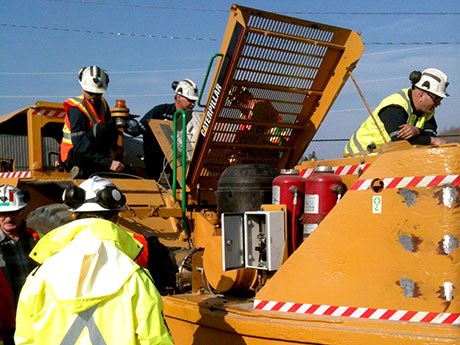99 per cent reduction in diesel particulate emissions
In Sudbury and the surrounding Northern Ontario mining landscape, diesel-powered equipment and machines are almost as common as the rocks they work hard to move. Diesel emissions and their impact on miners is a key issue and requires constant innovation.
The Canadian Mining Industry Research Organization (CAMIRO) has been working on a diesel emissions reduction project for the last 10 years with several leading mining companies. The goal is to always ensure the best efforts are being put forth to minimize the impact diesel emissions have on miners underground.
This is serious business. Diesel emissions have a chemical profile that contains polycyclic aromatic hydrocarbons (PAHs). Most diesel particles are small enough to be inhaled by the lungs, where they pose a significant health risk. Diesel exhaust contains 20 times more particles than gasoline exhaust. Some of the main toxic gases produced in diesel exhaust are nitrogen oxide, sulphur dioxide and carbon monoxide.
Needless to say, diesel emissions can be harmful and need to be controlled. Diesel, however, is a necessary evil in underground mines today. This is why CAMIRO has spent much time on research and development into diesel filter systems. The industry demands it. The industry and its workforce need it.
“Diesel is a mainstay in our mining methods,” said CAMIRO managing director Charlie Graham. “It’s a diesel world. It’s central to moving miners and material. We have accepted diesel emissions as a problem. It requires us to have care.”
CAMIRO is in the second year of a current three-year program of research and development on a new diesel emissions particle filter system and is working closely with industry partners Vale, Xstrata Nickel, Xstrata Copper and KGHM. The object is to test available methods of reducing diesel emissions to provide miners with the healthiest working environment possible. Prior to this program, CAMIRO and industry partners plugged away for years at solving diesel emission problems. It has been a painstaking process.
Filter systems have evolved over the last 10 years. Machines have used filter systems that collect diesel soot effectively, but were costly and time-consuming to maintain because they had to be treated and cleaned every eight to 16 hours. Current filter systems can regenerate themselves on the machine using heat from the exhaust, but they generate a great deal of NO2.
There are stricter industry regulations on how much NO2 a machine can produce and that has pushed CAMIRO to dig deeper and come up with a filter system that would make everyone happy. CAMIRO is using a filter made by Johnson Matthey of Germany that could be the answer to the problem. CAMIRO is co-ordinating an industry project to improve diesel engine exhaust quality for heavy duty, light duty, and diesel oxidation catalysts.The filter system has been tested extensively on a surface scoop tram at Totten Mine for more than 1,200 hours and is now being rebuilt to fix key issues discovered during the testing phase.
“We now have a filter we have been testing that, first, takes out the soot and then treats the NO2,” Graham said. “It’s all seamless and transparent to the operator. There is a 99-plus per cent reduction in diesel particulate matter, and acceptable levels of NO2. We are now having the diesel emission particulate filter rebuilt and making all the improvements. We will put it on to an underground scoop tram at a Vale location in March and run it for a calendar year and re-evaluate the progress. A stumbling block before was that the systems required more maintenance and produced operational restraints. Our mission this time was to find a filter that is as simple to use as a catalytic converter on a normal car.”
There are many factors to consider before the industry fully embraces the new filter systems CAMIRO is working on. Analysis of how the new filters affect machine maintenance and engine life must be accounted for, as well as the space they take up on equipment.
The filter will also need to be beefed up to withstand the harsh underground working environment.
“Stuff gets beat to hell underground. The new filters have to be more rugged. We have to understand the issues and conquer them. We now have technology that works well in managing soot and NO2. We are thrilled with the latest results, but more work has to be done. It’s a constant evaluation at this point.”



